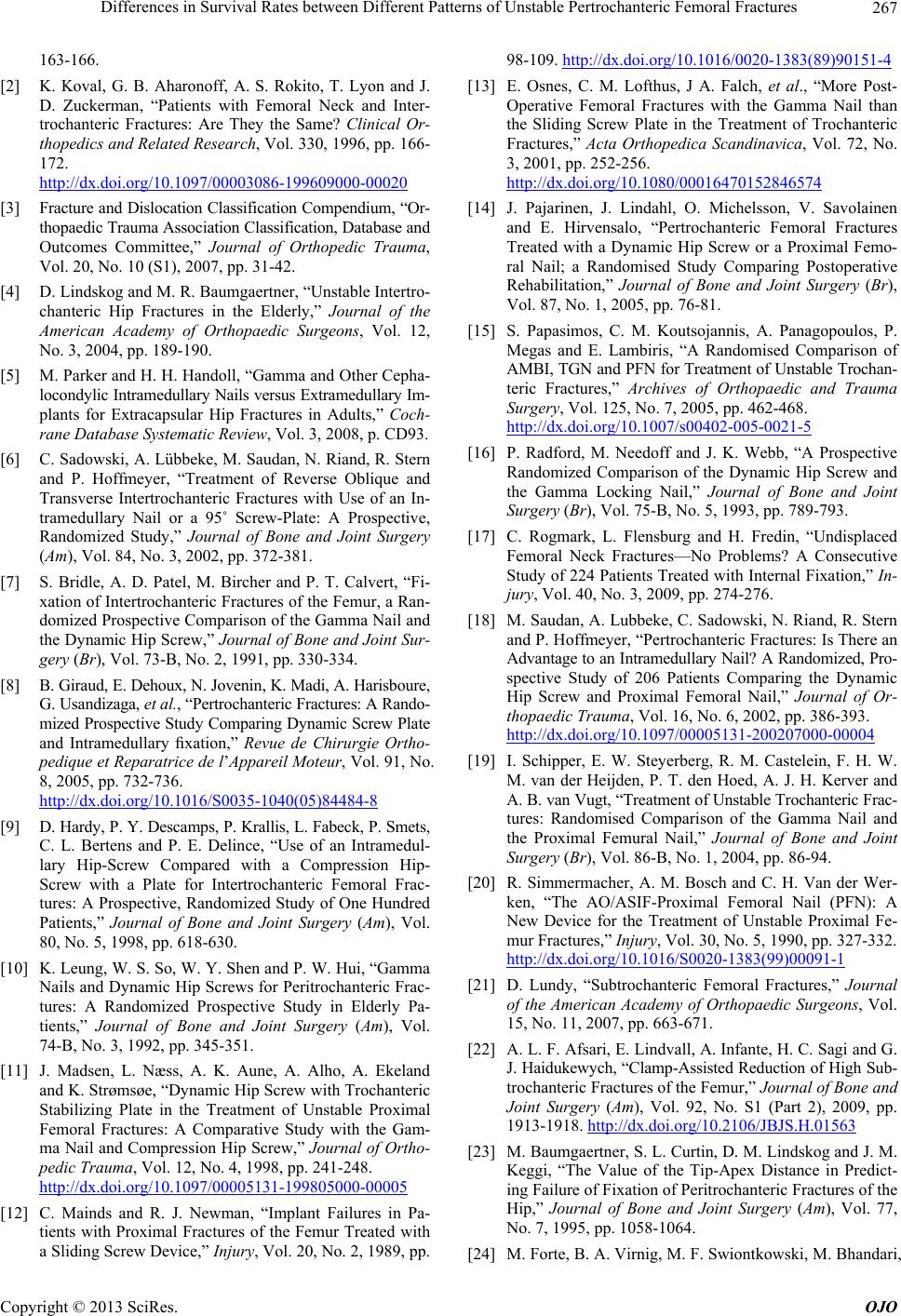
Differences in Survival Rates between Different Patterns of Unstable Pertrochanteric Femoral Fractures 267
163-166.
[2] K. Koval, G. B. Aharonoff, A. S. Rokito, T. Lyon and J.
D. Zuckerman, “Patients with Femoral Neck and Inter-
trochanteric Fractures: Are They the Same? Clinical Or-
thopedics and Related Research, Vol. 330, 1996, pp. 166-
172.
http://dx.doi.org/10.1097/00003086-199609000-00020
[3] Fracture and Dislocation Classification Compendium, “Or-
thopaedic Trauma Association Classification, Database and
Outcomes Committee,” Journal of Orthopedic Trauma,
Vol. 20, No. 10 (S1), 2007, pp. 31-42.
[4] D. Lindskog and M. R. Baumgaertner, “Unstable Intertro-
chanteric Hip Fractures in the Elderly,” Journal of the
American Academy of Orthopaedic Surgeons, Vol. 12,
No. 3, 2004, pp. 189-190.
[5] M. Parker and H. H. Handoll, “Gamma and Other Cepha-
locondylic Intramedullary Nails versus Extramedullary Im-
plants for Extracapsular Hip Fractures in Adults,” Coch-
rane Database Systematic Review, Vol. 3, 2008, p. CD93.
[6] C. Sadowski, A. Lübbeke, M. Saudan, N. Riand, R. Stern
and P. Hoffmeyer, “Treatment of Reverse Oblique and
Transverse Intertrochanteric Fractures with Use of an In-
tramedullary Nail or a 95˚ Screw-Plate: A Prospective,
Randomized Study,” Journal of Bone and Joint Surgery
(Am), Vol. 84, No. 3, 2002, pp. 372-381.
[7] S. Bridle, A. D. Patel, M. Bircher and P. T. Calvert, “Fi-
xation of Intertrochanteric Fractures of the Femur, a Ran-
domized Prospective Comparison of the Gamma Nail and
the Dynamic Hip Screw,” Journal of Bone and Joint Sur-
gery (Br), Vol. 73-B, No. 2, 1991, pp. 330-334.
[8] B. Giraud, E. Dehoux, N. Jovenin, K. Madi, A. Harisboure,
G. Usandizaga, et al., “Pertrochanteric Fractures: A Rando-
mized Prospective Study Comparing Dynamic Screw Plate
and Intramedullary fixation,” Revue de Chirurgie Ortho-
pedique et Reparatrice de l’Appareil Moteur, Vol. 91, No.
8, 2005, pp. 732-736.
http://dx.doi.org/10.1016/S0035-1040(05)84484-8
[9] D. Hardy, P. Y. Descamps, P. Krallis, L. Fabeck, P. Smets,
C. L. Bertens and P. E. Delince, “Use of an Intramedul-
lary Hip-Screw Compared with a Compression Hip-
Screw with a Plate for Intertrochanteric Femoral Frac-
tures: A Prospective, Randomized Study of One Hundred
Patients,” Journal of Bone and Joint Surgery (Am), Vol.
80, No. 5, 1998, pp. 618-630.
[10] K. Leung, W. S. So, W. Y. Shen and P. W. Hui, “Gamma
Nails and Dynamic Hip Screws for Peritrochanteric Frac-
tures: A Randomized Prospective Study in Elderly Pa-
tients,” Journal of Bone and Joint Surgery (Am), Vol.
74-B, No. 3, 1992, pp. 345-351.
[11] J. Madsen, L. Næss, A. K. Aune, A. Alho, A. Ekeland
and K. Strømsøe, “Dynamic Hip Screw with Trochanteric
Stabilizing Plate in the Treatment of Unstable Proximal
Femoral Fractures: A Comparative Study with the Gam-
ma Nail and Compression Hip Screw,” Journal of Ortho-
pedic Trauma, Vol. 12, No. 4, 1998, pp. 241-248.
http://dx.doi.org/10.1097/00005131-199805000-00005
[12] C. Mainds and R. J. Newman, “Implant Failures in Pa-
tients with Proximal Fractures of the Femur Treated with
a Sliding Screw Device,” Injury, Vol. 20, No. 2, 1989, pp.
98-109. http://dx.doi.org/10.1016/0020-1383(89)90151-4
[13] E. Osnes, C. M. Lofthus, J A. Falch, et al., “More Post-
Operative Femoral Fractures with the Gamma Nail than
the Sliding Screw Plate in the Treatment of Trochanteric
Fractures,” Acta Orthopedica Scandinavica, Vol. 72, No.
3, 2001, pp. 252-256.
http://dx.doi.org/10.1080/00016470152846574
[14] J. Pajarinen, J. Lindahl, O. Michelsson, V. Savolainen
and E. Hirvensalo, “Pertrochanteric Femoral Fractures
Treated with a Dynamic Hip Screw or a Proximal Femo-
ral Nail; a Randomised Study Comparing Postoperative
Rehabilitation,” Journal of Bone and Joint Surgery (Br),
Vol. 87, No. 1, 2005, pp. 76-81.
[15] S. Papasimos, C. M. Koutsojannis, A. Panagopoulos, P.
Megas and E. Lambiris, “A Randomised Comparison of
AMBI, TGN and PFN for Treatment of Unstable Trochan-
teric Fractures,” Archives of Orthopaedic and Trauma
Surgery, Vol. 125, No. 7, 2005, pp. 462-468.
http://dx.doi.org/10.1007/s00402-005-0021-5
[16] P. Radford, M. Needoff and J. K. Webb, “A Prospective
Randomized Comparison of the Dynamic Hip Screw and
the Gamma Locking Nail,” Journal of Bone and Joint
Surgery (Br), Vol. 75-B, No. 5, 1993, pp. 789-793.
[17] C. Rogmark, L. Flensburg and H. Fredin, “Undisplaced
Femoral Neck Fractures—No Problems? A Consecutive
Study of 224 Patients Treated with Internal Fixation,” In-
jury, Vol. 40, No. 3, 2009, pp. 274-276.
[18] M. Saudan, A. Lubbeke, C. Sadowski, N. Riand, R. Stern
and P. Hoffmeyer, “Pertrochanteric Fractures: Is There an
Advantage to an Intramedullary Nail? A Randomized, Pro-
spective Study of 206 Patients Comparing the Dynamic
Hip Screw and Proximal Femoral Nail,” Journal of Or-
thopaedic Trauma, Vol. 16, No. 6, 2002, pp. 386-393.
http://dx.doi.org/10.1097/00005131-200207000-00004
[19] I. Schipper, E. W. Steyerberg, R. M. Castelein, F. H. W.
M. van der Heijden, P. T. den Hoed, A. J. H. Kerver and
A. B. van Vugt, “Treatment of Unstable Trochanteric Frac-
tures: Randomised Comparison of the Gamma Nail and
the Proximal Femural Nail,” Journal of Bone and Joint
Surgery (Br), Vol. 86-B, No. 1, 2004, pp. 86-94.
[20] R. Simmermacher, A. M. Bosch and C. H. Van der Wer-
ken, “The AO/ASIF-Proximal Femoral Nail (PFN): A
New Device for the Treatment of Unstable Proximal Fe-
mur Fractures,” Injury, Vol. 30, No. 5, 1990, pp. 327-332.
http://dx.doi.org/10.1016/S0020-1383(99)00091-1
[21] D. Lundy, “Subtrochanteric Femoral Fractures,” Journal
of the American Academy of Orthopaedic Surgeons, Vol.
15, No. 11, 2007, pp. 663-671.
[22] A. L. F. Afsari, E. Lindvall, A. Infante, H. C. Sagi and G.
J. Haidukewych, “Clamp-Assisted Reduction of High Sub-
trochanteric Fractures of the Femur,” Journal of Bone and
Joint Surgery (Am), Vol. 92, No. S1 (Part 2), 2009, pp.
1913-1918. http://dx.doi.org/10.2106/JBJS.H.01563
[23] M. Baumgaertner, S. L. Curtin, D. M. Lindskog and J. M.
Keggi, “The Value of the Tip-Apex Distance in Predict-
ing Failure of Fixation of Peritrochanteric Fractures of the
Hip,” Journal of Bone and Joint Surgery (Am), Vol. 77,
No. 7, 1995, pp. 1058-1064.
[24] M. Forte, B. A. Virnig, M. F. Swiontkowski, M. Bhandari,
Copyright © 2013 SciRes. OJO